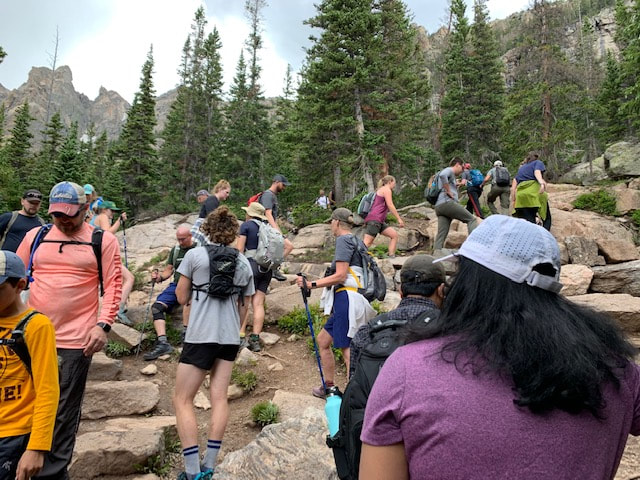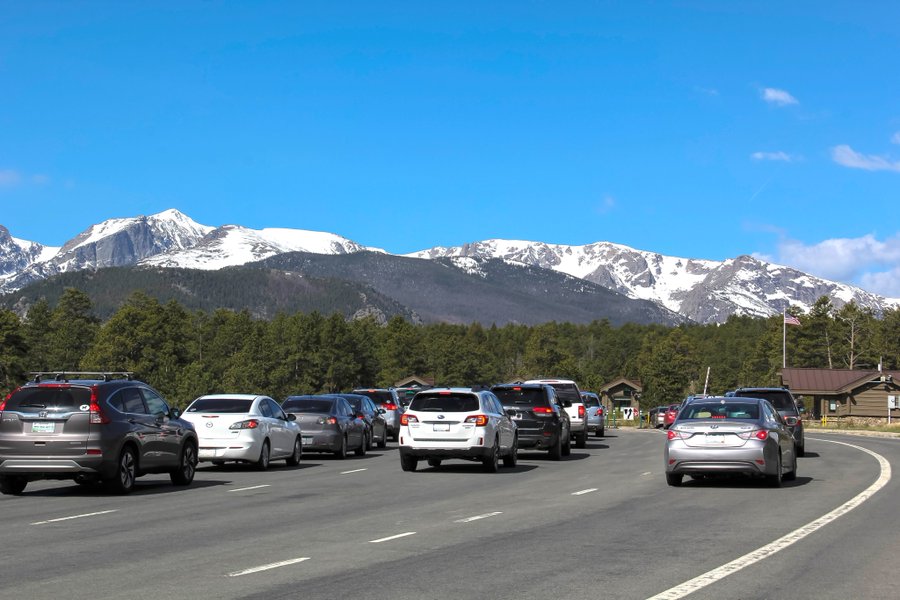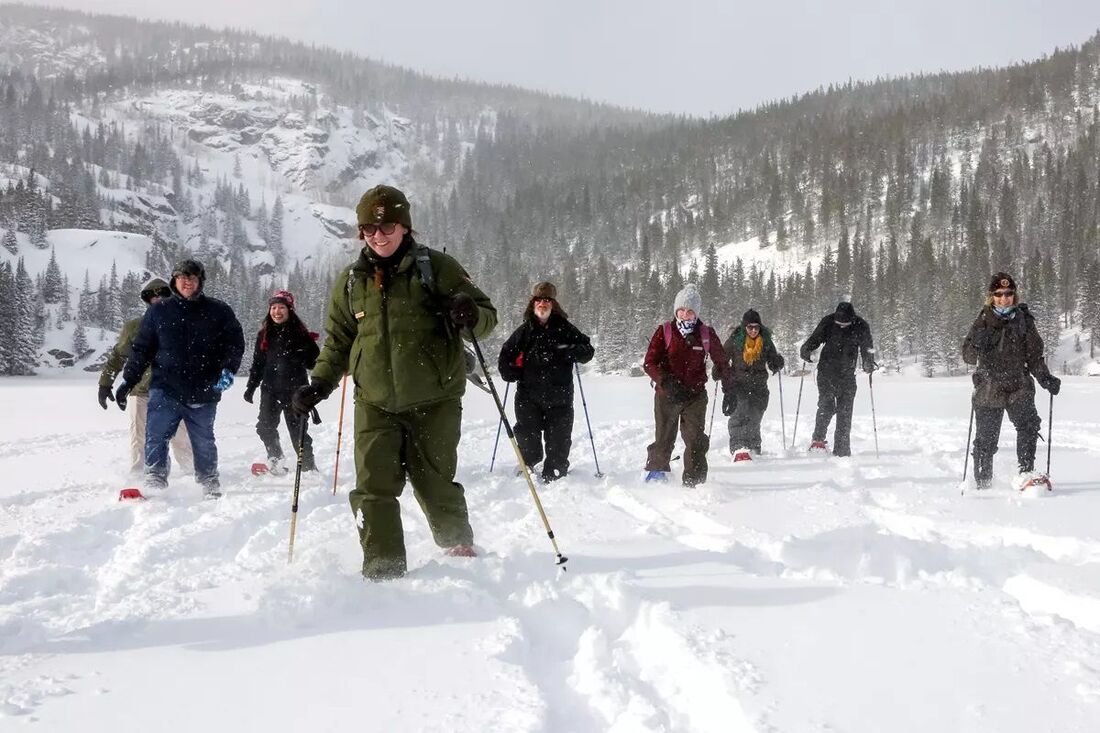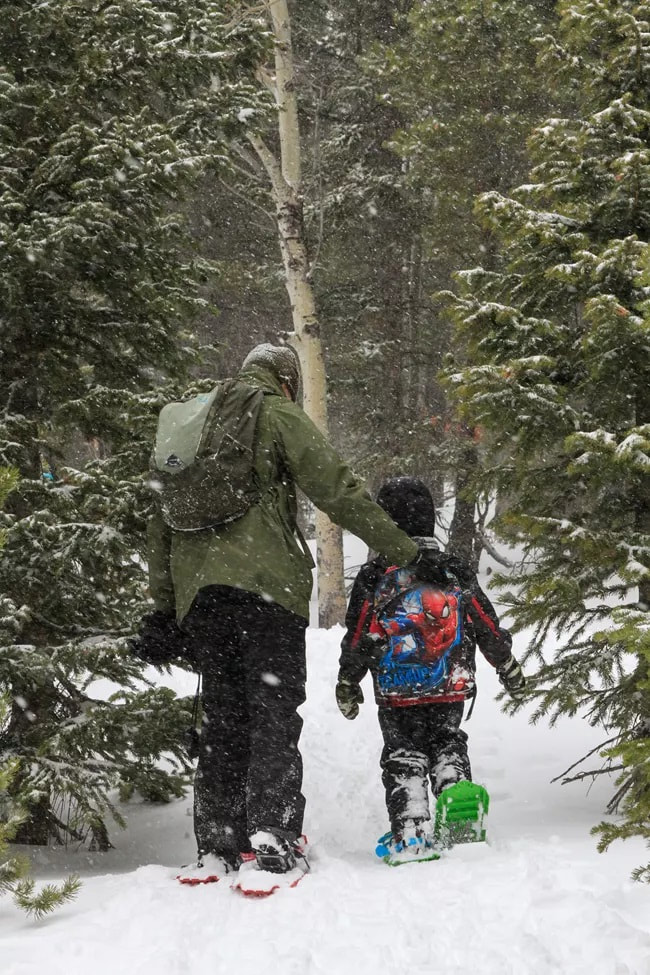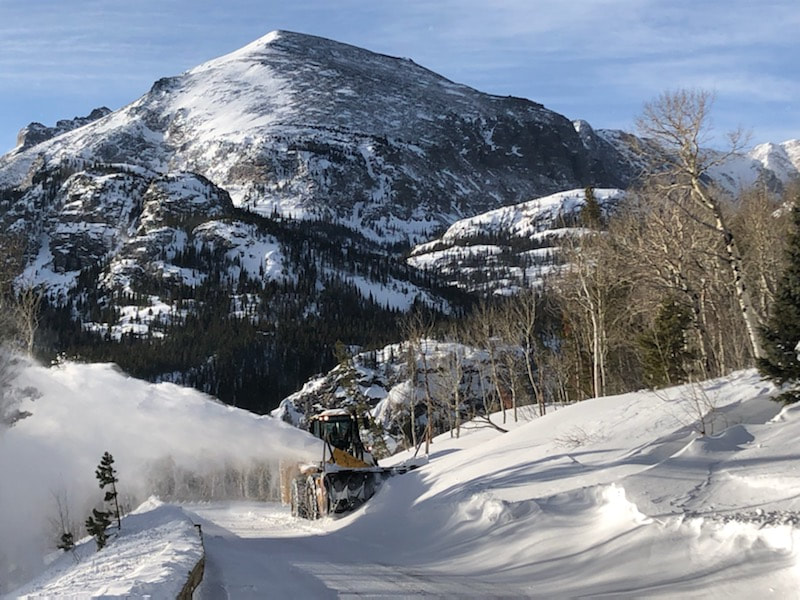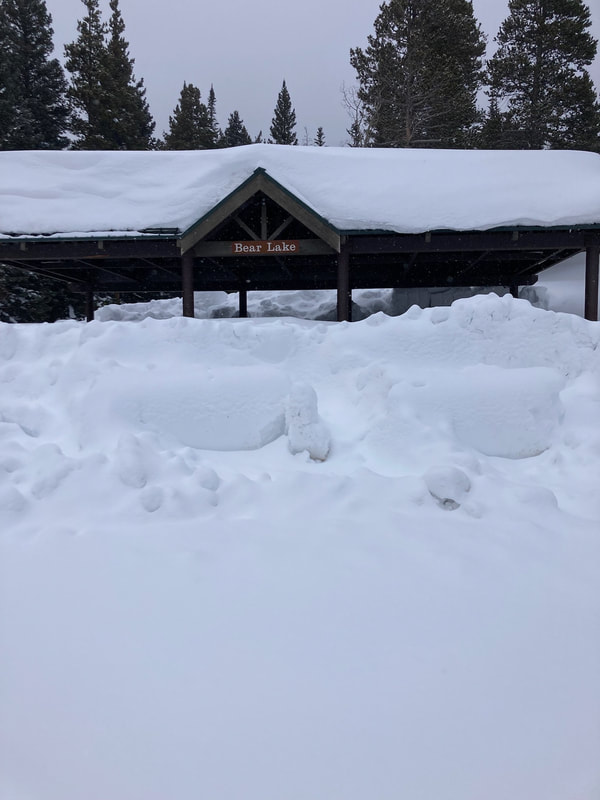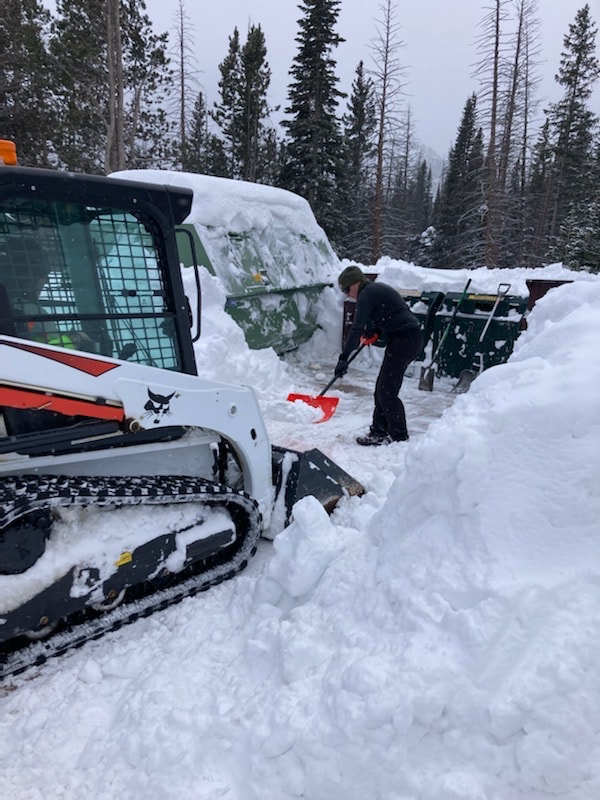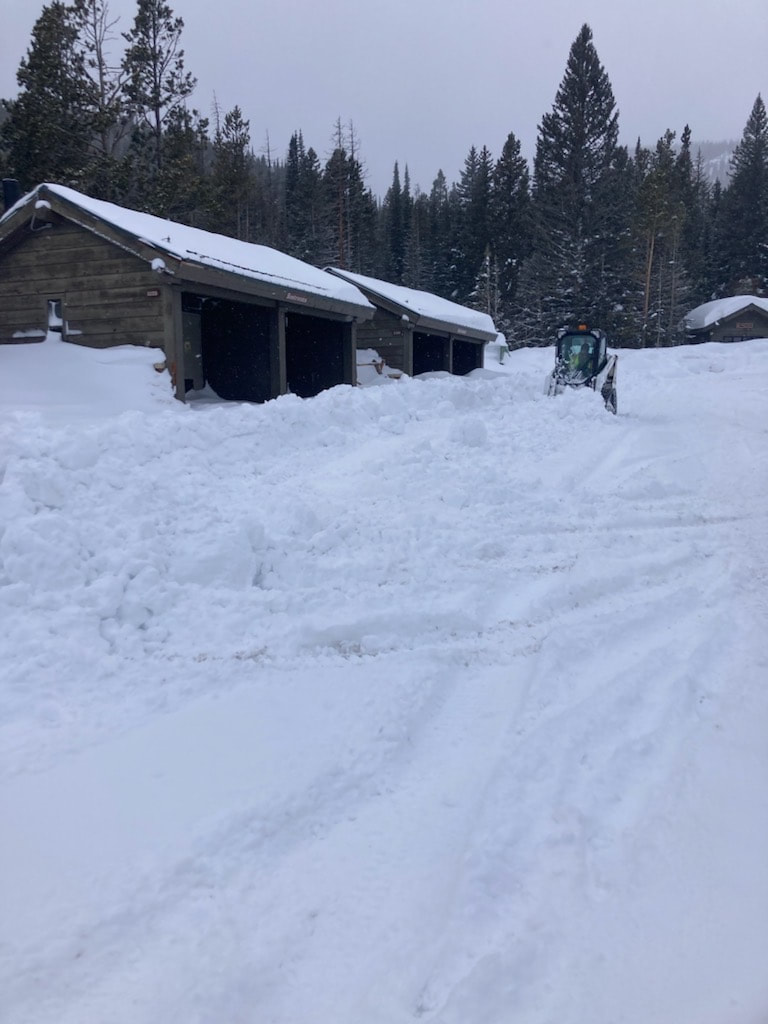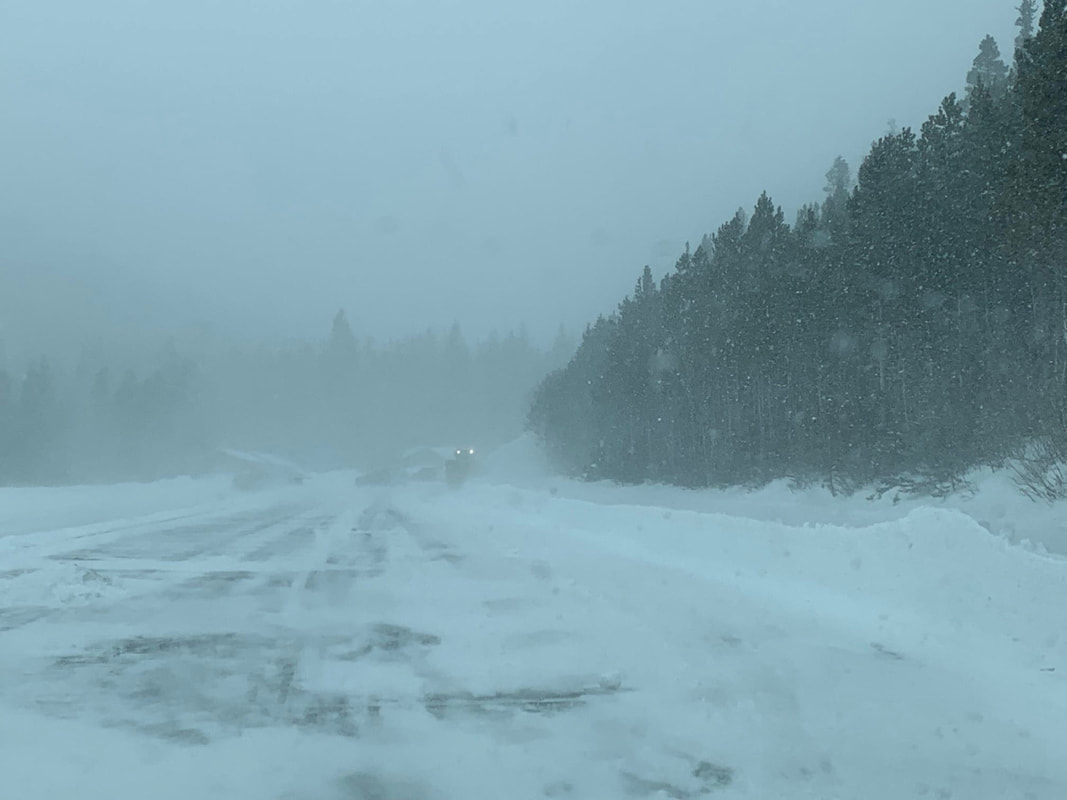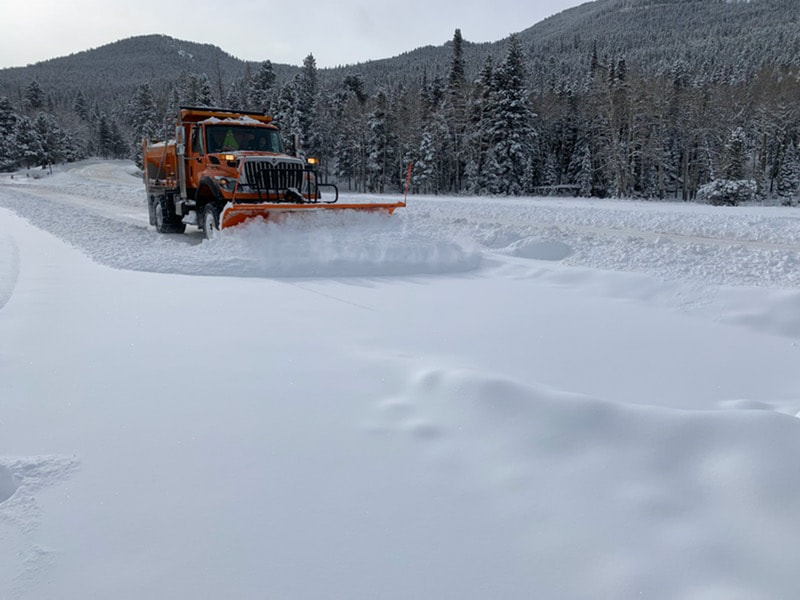|
RMNP UPDATE - January 31, 2022 Rocky Mountain National Park is one of the busiest national parks; third in the country in 2019, with over 4.6 million visitors. This represents a 42 percent increase in visitation in seven years, since 2012. Rapid growth in day use visitation and changing use patterns in the park have degraded natural and cultural resources, diminished quality of the visitor experience, increased negative impacts to visitor and staff safety and created a heavy strain on the park's facilities and ability to perform daily operations.
In response to these negative impacts, the park has piloted various visitor use management strategies over the last six years. From 2016-2019, this included managing vehicle access to first come, first served visitors in the highly congested areas of the Bear Lake Road corridor, the Alpine Visitor Center parking area and the Wild Basin area of the park. This strategy had some limited success initially, but over time began to lose effectiveness; the length of time they were necessary kept expanding and impacts were pushed elsewhere in the park. Park-wide timed entry permit reservation systems were piloted in 2020-2021, and the park will be piloting a similar system again in 2022. Park staff continue to learn from these various pilots which are helping to inform long-range day use visitor access strategies. This includes developing desired conditions, defining zones, and identifying indicators, thresholds, strategies and capacities. In May 2021, park staff held two pre-NEPA (National Environmental Policy Act) virtual public meetings on the long-range day use visitor access strategy. The meetings provided opportunities to learn more about the purpose of the project, key issues, desired conditions for day use visitor access, potential management strategies, and to ask questions of National Park Service(NPS) staff. In total, 271 people attended the public meetings. A recording of the meetings were posted on the park’s You Tube channel and the PDFs of the Power Point presentation and the visitor management zones map were posted on the park’s PEPC website as well. Public comments were invited for over sixty days beginning May 21 through July 26, 2021. During the review period, 571 correspondences were submitted to the NPS. Although the public comment period has closed for this pre-NEPA report, these webinars, including the presentation and Q & A, are available by clicking on Tuesday May 25 or Thursday May 20 (click on a date to watch a presentation - the content was the same for both meetings). Comments were reviewed and evaluated. To learn more about the pre-NEPA long-range day use visitor access strategy, the following reports can be found on the Planning, Environment and Public Comment (PEPC) https://parkplanning.nps.gov/ROMO_Duvas: Click on "document list" 1) An Executive Summary of the pre-NEPA Report for Day Use Visitor Access Strategy 2) A pre-NEPA Public Comment Summary for Day Use Visitor Access Strategy 3) A redacted copy of public comments submitted during the 2021 Pre-NEPA comment period These initial public comment meetings and comment opportunities are the first step in the long-range planning process. They assist park staff in defining the issues and their impacts as well as explore possible strategies and alternatives to address those issues. There will be more opportunities for public involvement in 2023, when the formal NEPA planning process is initiated. Park staff are eager to continue engaging park stakeholders and park visitors near and far to help identify shared values, clarify key issues, and develop potential management strategies to help the park prepare for long-term day use management. If would like more information about Rocky Mountain National Park, please visit www.nps.gov/romo or call the park’s Information Office at (970) 586-1206.
0 Comments
RMNP UPDATE - January 20, 2022 Rocky Mountain National Park is moving to a new wilderness backcountry camping permit reservation system this year. Beginning March 2, 2022, at 8 a.m. Mountain Time, Rocky Mountain National Park overnight wilderness backpacking camping permits will be available for purchase at Recreation.gov. Through the new system, customers will be able to view permit availability, book a reservation, and pay online. Phone, mail, email and fax reservations are not accepted. There will not be any in-person Wilderness Campsite reservations taken at park Wilderness Offices from March 1, through April 3, for summer wilderness backpacking camping trips from May 1 through October 31.
Permits are required for all overnight camping in Rocky Mountain National Park. The www.recreation.gov site is currently visible to the public. Become familiar with the site prior to March 2, when reservations go live. To be prepared, those interested in booking a wilderness camping trip this summer should set up an account with Recreation.gov in advance of March 2. This page includes important links to detailed information about Rocky Mountain National Park’s wilderness backcountry camping, including camping regulations, trail descriptions and maps. Beginning March 2, when reservations can be booked, search “Check Availability” to book small groups (1-7 people) and large groups (8-12 people). This specific feature will not be active until March 2. Be sure to review the map to determine what campsites to book and read through all the available information about Wilderness regulations and trail descriptions. Additional information with links is also located at https://www.nps.gov/romo/planyourvisit/wilderness-camping.htm. Starting at 8 a.m. on March 2, wilderness backcountry camping permits will be available for May 1 through October 31, 2022. There is a $36 non-refundable administrative fee, for reservations from May 1 to October 31 and a $10 non-refundable administrative fee from November 1 to April 30 for each camping permit reserved. Permits will need to be picked up at the park’s Wilderness Offices to activate the reservation. Wilderness camping permits help provide a quality experience, minimize impacts to resources, and ensure that sites are available for those who plan ahead and reserve a permit in advance. An overnight permit is required for backcountry camping year-round, and from May through October demand can exceed availability in certain areas of the park’s backcountry. Staff and volunteers in the park’s wilderness office provide trip planning advice and information for a safe and enjoyable trip into the wilderness. Requirements for food storage necessary to protect bears and other wildlife, mountain weather, hazards, and Leave No Trace ethics are among the information received during the permitting process. For further information about Rocky Mountain National Park please visit www.nps.gov/romo or call the park’s Information Office at (970) 586-1206. RMNP UPDATE - January 12, 2022
Rocky Mountain National Park will be implementing a pilot temporary timed entry permit reservation system beginning on May 27, 2022. The reservation permit system is similar to that used in 2021. Two types of reservations will be available. One permit will be for the Bear Lake Road Corridor, which includes the entire corridor, as well as access to the rest of the park. This reservation period will be from 5 am to 6 pm. The second permit will be for the rest of Rocky Mountain National Park, excluding the Bear Lake Road corridor. This reservation period will be from 9 am to 3 pm. Permits issued using the reservation system will allow park visitors to enter the park within two-hour windows of availability. The reservation system will apply to all areas of the park. Reservations to enter the park will go on sale through www.recreation.gov at 10 am Mountain Daylight Time on Saturday, May 2. This round of reservations will be available to enter the park from May 27 through June 30. The next release will occur on June 1, for the month of July and any remaining days that have not been booked for June. On July 1, reservations will be available for the month of August and any remaining days that have not been booked for July. On August 1, reservations will be available for the month of September and any remaining days in August that have not been booked. On September 1, reservations will be available for October and any remaining days in September that have not been booked. Initially, 30 percent of permits will be held and available for purchase the day prior at 5 p.m. through recreation.gov. These are expected to sell out quickly and visitors are encouraged to plan ahead when possible. This year’s pilot reservation system allows for a greater number of reservations per day. Reservations will be based on approximately 90 percent of the park’s total parking capacity. Last year’s system was based on approximately 75 to 85 percent of the park’s total parking capacity. This system spreads use throughout the park and throughout the day to better utilize all parking/trailhead areas. For more detailed information and Frequently Asked Questions on timed entry permits to help you prepare for the summer season, visit https://www.nps.gov/romo/planyourvisit/timed-entry-permit-system.htm Rocky Mountain National Park is one of the busiest national parks; third in the country in 2019 with over 4.6 million visitors. This represents a 42 percent increase in visitation in seven years. Visitor crowding and congestion at the park have led to increased negative impacts to visitor and staff safety, resource protection, visitor experience and operational capacity. The park has piloted various visitor use management strategies over the last six years, including managing vehicle access to first-come, first serve (2016-2019) in highly congested areas. These first-come, first-serve restrictions had some limited success initially, but over time began to lose effectiveness; the length of time they were necessary kept expanding and impacts were pushed elsewhere. The park piloted park wide timed entry permit reservation systems (2020-2021) and will be piloting a similar system again in 2022. The park is learning from these various strategies since 2016, to help inform long-range day use visitor access strategies. This includes developing desired conditions, defining zones, and identifying indicators, thresholds, strategies and capacities. Public meetings were held in May of 2021, and there will be additional opportunities for public input when the formal planning process is initiated. There are several different reservation systems that are being implemented across the National Park Service. Other national parks that have announced various types of reservation requirements this year include Arches National Park, Glacier National Park, Acadia National Park, Muir Woods National Monument, Shenandoah National Park, Haleakala National Park and Zion National Park. For further information about Rocky Mountain National Park please visit www.nps.gov/romo, follow the park on social media @RockyNPS or call the park’s Information Office at (970) 586-1206. RMNP UPDATE - January 10, 2021
An annual favorite for many park visitors, Rocky Mountain National Park’s Ranger-led Snowshoe Walks will resume this January on both the east and west side of the park. Programs will be offered weekly, as conditions allow, through March 2022. These programs are approximately 2 hours long and are open to visitors age 8 and older and all experience levels. Beginning snowshoers are welcome. There is no additional fee beyond the regular park entrance fee to participate. On the east side of the park, beginning on Tuesday, January 18, ranger-led snowshoe walks will be offered on Tuesdays and Thursdays at 12:30 pm. Advanced reservations are required. To make a reservation, please call 970-586-1223. Reservations can be booked up to 7 days in advance. Snowshoe walks typically fill quickly, especially if the weather is forecast to be warm and sunny. Snowshoes are not provided. Program participants will be required to bring their own or rent snowshoes outside the park. On the west side of the park, beginning on Saturday, January 22, ranger-led snowshoe walks will be offered on Saturdays at 1 pm. A ticket is required to participate. This no-cost ticket can be picked up on the day of the walk at the Kawuneeche Visitor Center. Snowshoes are provided for use during the guided program. For additional details, please visit Ranger-led Snowshoe Walks - Rocky Mountain National Park (U.S. National Park Service) (nps.gov) or call the park’s Information Office at (970) 586-1206. RMNP UPDATE - January 9, 2022, 1:02 p.m. Park roads and trail crews have been working to clear deep snow drifts along Bear Lake Road and along Fall River Road. Bear Lake Road is now open past Sprague Lake to Bear Lake and US 34 at the Fall River Entrance is open to all vehicles. For updates on roads, follow us on Twitter @RockyNPS. Roads are snowpacked and icy in places. 4-Wheel Drive and All-Wheel Drive Vehicles are advised. Be prepared for winter driving and hiking conditions. RMNP UPDATE: January 8, 2022, 2:57 pm US 36 at the Beaver Meadows Entrance on the east side of Rocky Mountain National Park is now open to vehicles. Trail Ridge Road is open to Many Parks Curve with access to the Hidden Valley area. Bear Lake Road is open to Sprague Lake and is closed beyond Sprague Lake to Bear Lake for continued snow removal operations.
US 34 at the Fall River Entrance to Deer Ridge Junction and Wild Basin Road remains closed to vehicles. Four wheel drive and all wheel drive vehicles are advised. 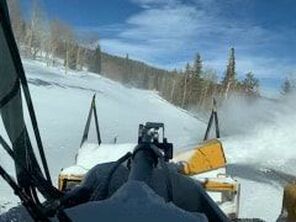 Plowing efforts in RMNP along Bear Lake Road January 7 2022 / Photo Courtesy RMNP Plowing efforts in RMNP along Bear Lake Road January 7 2022 / Photo Courtesy RMNP RMNP UPDATE - January 8, 2022, 9:09 AM Please note - photograph was taken yesterday, January 8, on Bear Lake Road when there was blue sky. It's currently snowing in that location this morning. Drifting snow caused by significant wind during and after the recent snowstorm continues to cause challenging conditions on the east side of Rocky Mountain National Park. This morning, snow and wind at higher elevations are again hampering efforts. Park snowplow operators are encountering drifts from 6 to 12 feet along sections of park roads above 8,500 feet. A drift above Hollowell Park, along Bear Lake Road at approximately 9,000 feet, is 300 yards long, 8 feet deep, and covers the full width of the road surface. There are numerous deep drifts along Trail Ridge Road from Beaver Meadows Entrance and Fall River Entrance to Deer Ridge Junction. Longtime park snowplow operators are comparing it to similar conditions when opening Trail Ridge Road above 12,000 feet for the season. One to ten inches of snow, along with wind gusts, can quickly cause significant drifts on roads. As plow drivers plow through some sections, the roads drift in behind them at the next gust. Warm temperatures on roadways prior to the storm, followed by frigid temperatures, then snow and rain added a thick layer of ice. Ice, winds, drifted and consolidated snow are impacting heavy equipment and rotary plows. These drifts cannot be pushed through with a typical snowplow. It takes time and specialized heavy duty equipment to cut through these drifts. Two lanes of roadway need to be accessible before sections of roads will be open to park visitors. For updated status on park roads please follow the park on Twitter @RockyNPS. RMNP UPDATE - January 6, 2022
Conditions are favorable today and tomorrow for Rocky Mountain National Park Fire Management staff to burn piles in the Moraine Park Campground and Lily Lake area. Smoke may be visible from multiple locations on the east side of the park and flames will likely be visible from the Lily Lake and Highway 7 near Lily Lake. Pile burning operations only begin when conditions allow. Safety factors, weather conditions, air quality and other environmental regulations are continually monitored as a part of any fire management operation. Why is this important? When fighting the East Troublesome Fire in 2020, firefighters were able to take advantage of previous and existing prescribed fire and hazardous fuels treatment areas that provided a buffer between the fire and the town of Estes Park. Prior hazard fuels projects aided considerably in stopping the fire from jumping Bear Lake Road and Trail Ridge Road. Years of hazardous fuels reduction projects and bark beetle tree removal on the west side were instrumental in the successful burnout operations around the town of Grand Lake and helped minimize structure loss in the main park housing area. Piles of slash in the park are from several fuels reduction projects and hazard tree removals. Slash from these projects has been cut and piled by park fire crews and contractors over the last two years and are now dry enough to burn. They are designed to reduce significant accumulations of forest fuels that can generate extreme or problematic fire behavior adjacent to wildland urban interface. By reducing the potential fire behavior the wildland fire risk to firefighters and the public is significantly reduced. However, these projects are not designed as a stand-alone defense against wildfires nor are they guaranteed to hold a wildfire in the worst conditions. To learn more about wildfire mitigation around homes visit www.firewise.org Prescribed fire smoke may affect your health. For more information see https://www.colorado.gov/pacific/cdphe/wood-smoke-and-health. RMNP UPDATE - January 5, 2021, 6:39 p.m. Due to winter storms and adverse road conditions, US 34 is closed at Grand Lake Entrance, US 36 is closed at Beaver Meadows Entrance and US 34 is closed at Fall River Entrance.
For updated road status please follow us on twitter @RockyNPS Kyle Patterson Management Specialist/Public Affairs Officer Rocky Mountain National Park (970) 586-1363 www.nps.gov/romo www.facebook.com/RockyNPS RMNP UPDATE - January 1, 2022
Beaver Meadows Entrance and Fall River Entrance on the east side of Rocky Mountain National Park have reopened to vehicle traffic. Bear Lake Road and Trail Ridge Road above Deer Ridge Junction remain closed for plow operations. There is no anticipated time for reopening. Roads on the west side of the park are open. All park roads are icy and snowpacked. 4wd and all wheel drive or 2wd with snow chains or alternate traction devices are required. Wild Basin Entrance remains closed to vehicles. Snowfall from recent storm varies based on elevation, but new accumulation of roughly 10 inches to 13 inches from 7,800 feet to 9, 800 feet. |
RMNP UpdatesPress Releases from Rocky Mountain National Park and the Rocky Mountain Conservancy.
Archives
September 2025
|
© Copyright 2025 Barefoot Publications, All Rights Reserved

